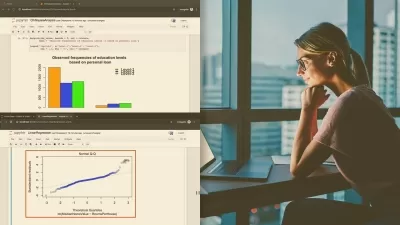Machine Learning with R
EDUCBA Bridging the Gap
24:51:16
Description
Learn how to use the R programming language for data science and machine learning and data visualization
What You'll Learn?
- Read In Data Into The R Environment From Different Sources
- Implement Unsupervised/Clustering Techniques Such As k-means Clustering
- Implement Supervised Learning Techniques/Classification Such As Random Forests
- Be Able To Harness The Power Of R For Practical Data Science
Who is this for?
What You Need to Know?
More details
DescriptionData Scientist has been ranked the number one job on Glassdoor and the average salary of a data scientist is over $120,000 in the United States according to Indeed! Data Science is a rewarding career that allows you to solve some of the world's most interesting problems! This course is designed for both complete beginners with no programming experience or experienced developers looking to make the jump to Data Science! This comprehensive course is comparable to other ML bootcamps that usually cost thousands of dollars, but now you can learn all that information at a fraction of the cost! this is one of the most comprehensive course for data science and machine learning. We'll teach you how to program with R, how to create amazing data visualizations, and how to use Machine Learning with R!
Machine learning is a scientific discipline that explores the construction and study of algorithms that can learn from data. Such algorithms operate by building a model from example inputs and using that to make predictions or decisions, rather than following strictly static program instructions. Machine learning is closely related to and often overlaps with computational statistics; a discipline that also specializes in prediction-making. This training is an introduction to the concept of machine learning and its application using R tool.
The training will include the following:
Introducing Machine Learning
a. The origins of machine learning
b. Uses and abuses of machine learning
Ethical considerations
How do machines learn?
Steps to apply machine learning to your data
Choosing a machine learning algorithm
Using R for machine learning
Forecasting Numeric Data – Regression Methods
Understanding regression
Example – predicting medical expenses using linear regression
a. collecting data
b. exploring and preparing the data
c. training a model on the data
d. evaluating model performance
e. improving model performance
Who this course is for:
- Anyone who wants to learn about data and analytics, Data Engineers, Analysts, Architects, Software Engineers, IT operations, Technical managers
Data Scientist has been ranked the number one job on Glassdoor and the average salary of a data scientist is over $120,000 in the United States according to Indeed! Data Science is a rewarding career that allows you to solve some of the world's most interesting problems! This course is designed for both complete beginners with no programming experience or experienced developers looking to make the jump to Data Science! This comprehensive course is comparable to other ML bootcamps that usually cost thousands of dollars, but now you can learn all that information at a fraction of the cost! this is one of the most comprehensive course for data science and machine learning. We'll teach you how to program with R, how to create amazing data visualizations, and how to use Machine Learning with R!
Machine learning is a scientific discipline that explores the construction and study of algorithms that can learn from data. Such algorithms operate by building a model from example inputs and using that to make predictions or decisions, rather than following strictly static program instructions. Machine learning is closely related to and often overlaps with computational statistics; a discipline that also specializes in prediction-making. This training is an introduction to the concept of machine learning and its application using R tool.
The training will include the following:
Introducing Machine Learning
a. The origins of machine learning
b. Uses and abuses of machine learning
Ethical considerations
How do machines learn?
Steps to apply machine learning to your data
Choosing a machine learning algorithm
Using R for machine learning
Forecasting Numeric Data – Regression Methods
Understanding regression
Example – predicting medical expenses using linear regression
a. collecting data
b. exploring and preparing the data
c. training a model on the data
d. evaluating model performance
e. improving model performance
Who this course is for:
- Anyone who wants to learn about data and analytics, Data Engineers, Analysts, Architects, Software Engineers, IT operations, Technical managers
User Reviews
Rating
EDUCBA Bridging the Gap
Instructor's Courses
Udemy
View courses Udemy- language english
- Training sessions 156
- duration 24:51:16
- Release Date 2024/03/17

















